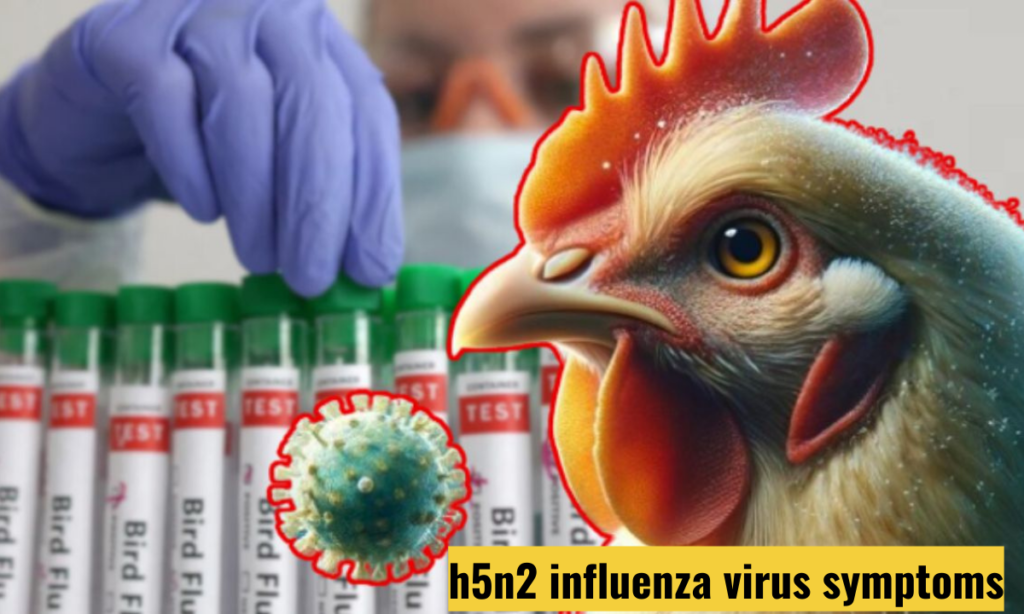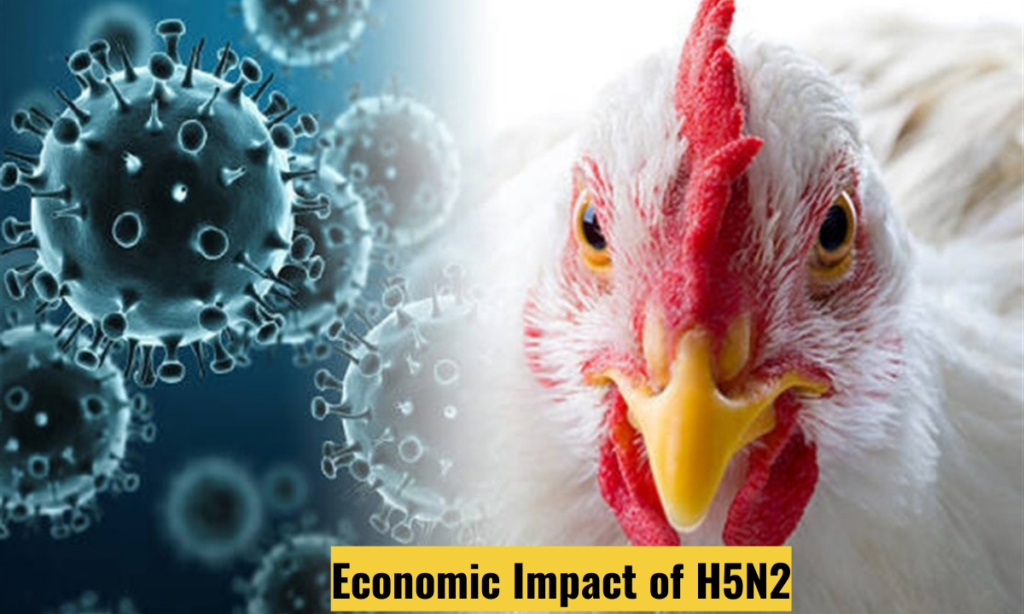H5N2 Avian Influenza Breakout
 Introduction
Introduction
What comes to mind when you hear about H5N2 Avian Influenza Breakout? For many, it’s a faint memory of news reports about bird flu outbreaks. However, the H5N2 strain of avian influenza is a real and present threat that has profound implications for both the poultry industry and public health. So, what exactly is H5N2 Avian Influenza, and why should we care ? Read more..
What is H5N2 Avian Influenza ?
 H5N2 Avian Influenza is a subtype of the Influenza A virus primarily affecting birds. It falls under the category of Highly Pathogenic Avian Influenza (HPAI) due to its severe impact on poultry. While it’s less known compared to H5N1, its outbreaks can be equally devastating.
H5N2 Avian Influenza is a subtype of the Influenza A virus primarily affecting birds. It falls under the category of Highly Pathogenic Avian Influenza (HPAI) due to its severe impact on poultry. While it’s less known compared to H5N1, its outbreaks can be equally devastating.
Brief History of H5N2 Avian Influenza Breakout
The H5N2 virus (H5N2 Avian Influenza Breakout has caused significant outbreaks over the years, with notable incidents in North America, Asia, and Europe. Each outbreak led to massive culling of poultry to contain the virus, resulting in significant economic losses and heightened fears of potential human transmission.
Understanding Avian Influenza
Different Strains of Avian Influenza
Avian influenza viruses are classified based on two proteins on their surface: Hemagglutinin (H) and Neuraminidase (N). The combination of these proteins gives rise to different strains like H5N1, H7N9, and H5N2. Each strain has unique characteristics and varying levels of pathogenicity.
How H5N2 Differs from Other Strains
H5N2 (H5N2 Avian Influenza Breakout), unlike some other avian influenza strains, has shown a tendency to spread rapidly among poultry but has a relatively low incidence of transmission to humans. However, this doesn’t reduce the threat it poses to the poultry industry and the potential risks associated with mutations.
The Science Behind H5N2
 Structure and Characteristics of the Virus
Structure and Characteristics of the Virus
H5N2(H5N2 Avian Influenza Breakout ) is an influenza A virus characterized by its high virulence in birds. The virus’s structure includes the hemagglutinin and neuraminidase proteins, which play critical roles in the virus’s ability to infect and spread.
Transmission Methods
The virus primarily spreads through direct contact with infected birds, their droppings, or contaminated surfaces. Wild birds, particularly waterfowl, often act as carriers, spreading the virus across vast regions during migration.
Impact on Poultry Industry
 Economic Consequences
Economic Consequences
H5N2 (H5N2 Avian Influenza Breakout )outbreaks lead to substantial economic losses due to the culling of infected and exposed poultry. The costs include not only the immediate loss of livestock but also the long-term impacts on trade and poultry product markets.
Effects on Poultry Health
Infected birds exhibit severe symptoms, including respiratory distress, decreased egg production, and high mortality rates. These symptoms drastically affect poultry health and productivity, necessitating stringent control measures.
h5n2 influenza virus symptoms
 Visible Signs in Infected Birds
Visible Signs in Infected Birds
Birds infected with H5N2 typically show signs such as coughing, sneezing, swelling around the head and neck, and a drop in egg production. In severe cases, sudden death can occur without any preceding symptoms.
Diagnostic Methods
Diagnosis of H5N2 involves laboratory tests, including PCR (polymerase chain reaction) to detect viral RNA, and serological tests to identify antibodies. Early detection is crucial for controlling outbreaks and preventing widespread transmission.
Human Health Concerns
 Potential Risks to Humans
Potential Risks to Humans
While H5N2 (H5N2 Avian Influenza Breakout ) is primarily a bird virus, there is always a concern about zoonotic transmission—where viruses jump from animals to humans. Although rare, human infections with avian influenza can occur, particularly among those in close contact with infected birds.
Previous Human Infections with Avian Influenza Strains
Other strains of avian influenza, such as H5N1 and H7N9, have infected humans, sometimes resulting in severe respiratory illness and death. These instances underscore the importance of monitoring H5N2 and other avian influenza viruses for potential human health risks.
Preventive Measures in Poultry Farms
 Biosecurity Protocols
Biosecurity Protocols
Poultry farms must implement strict biosecurity measures to prevent H5N2 outbreaks (H5N2 Avian Influenza Breakout ). These include controlling access to farms, ensuring proper sanitation, and monitoring bird health closely.
Vaccination Strategies
Vaccination can be an effective tool in controlling H5N2 outbreaks. However, its use is often debated due to potential trade restrictions and the need for matching vaccines to circulating virus strains.
Government and International Response
Policies Implemented by Various Countries
Countries have developed specific policies to manage avian influenza outbreaks, including mandatory reporting of cases, culling of affected flocks, and compensation schemes for farmers. These measures aim to contain the virus and minimize economic losses.
Role of International Organizations like WHO and FAO
The World Health Organization (WHO) and the Food and Agriculture Organization (FAO) play crucial
roles in coordinating international responses to avian influenza outbreaks. They provide guidelines, facilitate information sharing, and support research and capacity-building efforts to help countries manage and prevent H5N2 outbreaks effectively.
Case Studies of H5N2 Outbreaks
Notable H5N2 Outbreaks in History
United States (2014-2015): The H5N2 outbreak in the United States resulted in the culling of over 48 million birds, primarily affecting the Midwest. This outbreak highlighted the need for rapid response and robust biosecurity measures.
Taiwan (2015): Taiwan experienced a significant H5N2 outbreak, leading to the culling of over 1 million birds. This incident underscored the importance of vigilant surveillance and early detection.
Lessons Learned from These Cases
These outbreaks taught us that early detection, rapid response, and stringent biosecurity measures are critical in controlling the spread of H5N2. Additionally, international cooperation and information sharing are essential in managing such global threats.
Research and Development
Current Research Efforts
Research on H5N2(H5N2 Avian Influenza Breakout ) focuses on understanding the virus’s behavior, improving diagnostic methods, and developing effective vaccines. Scientists are also exploring the genetic mutations that could increase the virus’s ability to infect humans.
Future Directions for Vaccines and Treatments
Future efforts include developing broad-spectrum vaccines that can protect against multiple avian influenza strains and antiviral treatments that can mitigate the effects of the virus in infected birds and potentially humans.
Public Awareness and Education
Importance of Educating Poultry Farmers
Educating poultry farmers about the signs of H5N2(H5N2 Avian Influenza Breakout , preventive measures, and the importance of reporting outbreaks is crucial. Awareness programs can help farmers implement biosecurity measures effectively and reduce the risk of widespread outbreaks.
Role of Media and Public Health Campaigns
Media and public health campaigns play a vital role in raising awareness about H5N2 (H5N2 Avian Influenza Breakout ). By disseminating accurate information and guidelines, these campaigns can help prevent panic and ensure that the public and poultry industry stakeholders take appropriate actions.
Challenges in Controlling H5N2
Limitations of Current Methods
Despite advancements in detection and prevention, controlling H5N2(H5N2 Avian Influenza Breakout remains challenging due to factors like the virus’s ability to mutate, the difficulty in vaccinating wild bird populations, and the need for constant vigilance.
Emerging Threats and New Strains
New strains of avian influenza continue to emerge, posing ongoing challenges for control efforts. Continuous monitoring and adaptation of strategies are necessary to keep pace with these evolving threats.
The Role of Technology in Managing Outbreaks
Use of AI and Data Analytics
Artificial intelligence and data analytics can significantly enhance our ability to predict and manage H5N2 outbreaks. These technologies can analyze vast amounts of data to identify patterns, predict outbreaks, and optimize response strategies.
Innovations in Surveillance and Detection
Innovations in surveillance, such as portable diagnostic devices and real-time data collection tools, are improving our ability to detect and respond to H5N2 outbreaks (H5N2 Avian Influenza Breakout quickly and efficiently.
Economic Impact of H5N2
 Cost of Containment and Control Measures
Cost of Containment and Control Measures
The economic impact of H5N2(H5N2 Avian Influenza Breakout includes the costs of containment measures such as culling, compensation for farmers, and the implementation of biosecurity protocols. These costs can be substantial, especially for large-scale outbreaks.
Long-term Economic Effects on the Poultry Industry
Long-term effects include reduced poultry production, trade restrictions, and loss of consumer confidence in poultry products. The ripple effects can impact related industries, leading to broader economic consequences.
Conclusion
H5N2 avian influenza (H5N2 Avian Influenza Breakout is a formidable threat that requires ongoing vigilance, robust biosecurity measures, and international cooperation to manage effectively. While significant progress has been made in understanding and controlling the virus, the challenges remain substantial. By leveraging technology, continuing research, and raising public awareness, we can better prepare for and mitigate the impacts of future outbreaks.
FAQs
- What is H5N2 Avian Influenza ?
H5N2 Avian Influenza(H5N2 Avian Influenza Breakout is a subtype of the Influenza A virus that primarily affects birds, causing severe illness and high mortality rates in poultry. - How does H5N2 spread among birds ?
H5N2 spreads through direct contact with infected birds, their droppings, and contaminated surfaces. Wild birds, especially waterfowl, can carry and spread the virus over long distances. - Can humans contract H5N2 ?
While H5N2(H5N2 Avian Influenza Breakout primarily affects birds, there is a potential risk of zoonotic transmission. However, human infections with this strain are rare and usually occur in people with close contact with infected birds. - What measures can poultry farmers take to prevent H5N2 ?
Poultry farmers can implement biosecurity protocols such as controlling farm access, maintaining proper sanitation, and monitoring bird health. Vaccination and early detection through regular testing are also crucial. - How does the government respond to H5N2 outbreaks ?
Governments typically respond by mandating the culling of infected and exposed birds, implementing quarantine measures, and compensating affected farmers. They also collaborate with international organizations to monitor and control the spread of the virus. - How to diagnose avian influenza in birds ?
After the disease has healed, birds with AI infections can be further identified by hemagglutinin and neuraminidase subtype based on hemagglutinin inhibition and neuraminidase inhibition tests, respectively. This can be done by serologic testing for influenza virus A (AGID or ELISA). - What is H5N2 bird flu ?
One type of avian influenza virus is H5N2(H5N2 Avian Influenza Breakout , which was identified in a deceased male in Mexico. Although it kills chickens, does it really provide a serious risk to people? WHO verified that a Mexican male passed away from avian flu. - What is the difference between H1N1 and H5N1 ?
Thus far, there has been relatively little human-to-human transmission of the H5N1 influenza virus. On the other hand, compared to the 2009 H1N1 influenza virus, which had a fatality rate of about 1%, it has an extraordinarily high fatality rate of over 60% (WHO 2009a). - Why is it called avian flu ?
The term “avian influenza” or “bird flu” describes the illness brought on by infection with Type A viruses that cause bird flu. These viruses can infect domestic poultry as well as other bird and animal species. They are naturally distributed among wild aquatic birds worldwide. - History of avian influenza ?
In 1997, an outbreak of avian influenza A virus subtype H5N1 in poultry in Hong Kong caused serious disease in eighteen people, with one-third of them dying. This marked the first documented cases of the virus in humans.
Bird flu is caused by
infections by the HPAI A(H5N1) virus in animals
It is known that HPAI A(H5) viruses can sporadically infect animals exposed to high viral concentrations, such as mammals that consume (possibly infected) birds or chickens. - H5N1 origin ?
The highly deadly H5N1 avian influenza virus was initially discovered in Southern China in domestic waterfowl in 1996. Name of the virus: A/goose/Guangdong/1/1996. China and Hong Kong experienced H5N1 poultry outbreaks in 1997, which resulted in 18 linked human cases—six of which were fatal—in Hong Kong.
